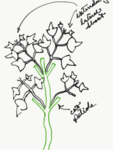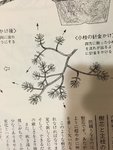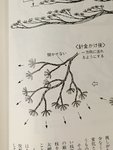You are using an out of date browser. It may not display this or other websites correctly.
You should upgrade or use an alternative browser.
You should upgrade or use an alternative browser.
Defoliation 101
- Thread starter markyscott
- Start date
markyscott
Imperial Masterpiece
I think I can post them now. @Bonsai Nut - you can delete post #64 if you’re inclined.
@choppychoppy - these were the sketches I tried to post to illustrate what I find difficult to understand about your picture. Here’s what I expect to see. Starting with a normal spring shoot:

It extends. At regular intervals it sets a node. At each node there is a dormant lateral bud waiting to be activated and a pair of opposite leaves. The leaves are connected to the shoot by a stem called a petiole. When we defoliate we cut through the petiole, leaving part of the stem connected to the shoot in order to not damage the dormant lateral bud at the base of the stem. If we shoot prune too, we cut off the terminal bud at the end of the shoot. When we’re done, it looks like this:

This is important. There are no leaves attached to the main stem. Where we’ve removed leaves there are cut petioles that remain. At the base of each petiole, there is a dormant bud that we’ve, hopefully, activated by pruning the shoot. After a few weeks, it looks like this:

New shoots extend from each of the dormant buds. There are still no leaves attached to the main stem. Instead, the shoot has thrown new shoots and the leaves are attached to them. In your picture:

I see an extended shoot. There are leaves attached and there are dormant buds at the base of each petiole. There are no secondary shoots that have extended from the main shoot. It looks all the world like the fist sketch above - a spring shoot that has not been pruned or defoliated. I take you at your word that you’ve defoliated it, but how it regenerated new leaves on the main shoot without activating any of the dormant buds and where the cut petioles went is a riddle, wrapped in a mystery, inside an enigma, but perhaps there is a key.
Scott
sorce
Nonsense Rascal
. I have cut old leaves in half which didn’t seem to do much
I reckon this will strengthen interior buds, since more light is had.
However this is twice or three times removed from an actual trigger.
One, half.
Two, defoliate with no shoot prune.
And thricish...its a broadleaf evergreen.
I remove last year's leaves on boxwood all day, until further notice, I don't see broadleaf evergreens varying much, so we should be able to speak of them in the same.
Usually ratty, brown or cracked, or just off looking at the node, where a branch has already grown, I remove them regularly for aesthetic purposes and have never realized a reaction.
For me...a leaf older than one year old on any tree that keeps em, is expendable as far as the tree is concerned. Like a battery that stores Extra solar power. Not really necessary, or active at all, if you are generating enough power with the panels.
Sorce
sorce
Nonsense Rascal
For clip and grow practitioners and all, leaves direct a bud and branch.
Sometimes (species), removing leaves allows the bud to grow at a perfect 90 degree angle. This should be considered.
Really anal folks (like me) might even consider the time it takes for the cut petiole to fall, as it will hold older buds in direction longer. But if no buds are present (visible) at the time of cutting, 90 degree angles are more likely.
Sorce
Sometimes (species), removing leaves allows the bud to grow at a perfect 90 degree angle. This should be considered.
Really anal folks (like me) might even consider the time it takes for the cut petiole to fall, as it will hold older buds in direction longer. But if no buds are present (visible) at the time of cutting, 90 degree angles are more likely.
Sorce
For clip and grow practitioners and all, leaves direct a bud and branch.
Sometimes (species), removing leaves allows the bud to grow at a perfect 90 degree angle. This should be considered.
Really anal folks (like me) might even consider the time it takes for the cut petiole to fall, as it will hold older buds in direction longer. But if no buds are present (visible) at the time of cutting, 90 degree angles are more likely.
Sorce
You don’t want 90 degree angles. You want something like 45 to 30 degree angles.
Here is a branch, as seen from above with 90 degree angles:

Same branch, but now pictured with 45 degree angles:

Here is a branch, as wired by Kimura

They’re tighter than 45s, more like 30 degrees, maybe even tighter!
markyscott
Imperial Masterpiece
How about Natal plum?
ABC - I’ve not worked much with Natal plum. Fairly sure that they do fine with the techniques we’ve described in here.
Michael P
Omono
Natal plum would be difficult to defoliate since the leaves are almost completely sessile--no petioles. I've never defoliated mine.
ABCarve
Masterpiece
I seem to recall a thread where someone had done a Natal plum multiple times a year. Can’t find it now. What’s the difference between them? Bay laurel, Carissa, boxwood, elaeagnus.I reckon this will strengthen interior buds, since more light is had.
However this is twice or three times removed from an actual trigger.
One, half.
Two, defoliate with no shoot prune.
And thricish...its a broadleaf
markyscott
Imperial Masterpiece
I seem to recall a thread where someone had done a Natal plum multiple times a year. Can’t find it now. What’s the difference between them? Bay laurel, Carissa, boxwood, elaeagnus.
The varieties you mentioned are all different genera. Different species respond differently to defoliation - some respond better than others. For instance, I would never purposefully remove all the leaves from a boxwood branch that I wanted to keep. It accomplishes nothing - it does not cause division, it does not reduce leave size, it does not cause backbudding. So what reason could there be for doing so and taking the risk of possibly losing the branch?
What is your objective? Are you talking about 100% defoliation, leaving no leaves? I can understand doing that right before a show, but other than that, for what purpose would someone do that multiple times a year? Let’s focus on goals - post a picture of your tree (either in this thread or your own) and tell us what you’re trying to accomplish.
Scott
ABCarve
Masterpiece
I guess it’s a more general question. I’m looking for some plant physiology about what determines a plants ability to tolerate it or not. What is the behavior if it’s done. Is there a list? BTW this is a great thread... thank you!!The varieties you mentioned are all different genera. Different species respond differently to defoliation - some respond better than others. For instance, I would never purposefully remove all the leaves from a boxwood branch that I wanted to keep. It accomplishes nothing - it does not cause division, it does not reduce leave size, it does not cause backbudding. So what reason could there be for doing so and taking the risk of possibly losing the branch?
What is your objective? Are you talking about 100% defoliation, leaving no leaves? I can understand doing that right before a show, but other than that, for what purpose would someone do that multiple times a year? Let’s focus on goals - post a picture of your tree (either in this thread or your own) and tell us what you’re trying to accomplish.
Scott
markyscott
Imperial Masterpiece
I guess it’s a more general question. I’m looking for some plant physiology about what determines a plants ability to tolerate it or not. What is the behavior if it’s done. Is there a list? BTW this is a great thread... thank you!!
Thank you - and I thought about your question a lot. Although I’m probably the wrong person to lead a discussion about the impact of plant physiology on defoliation, there are others here that might be able to do so. I can talk in general terms about auxin levels and how trees respond hormonally to shoot pruning, but that is not my expertise.
Scott
markyscott
Imperial Masterpiece
I guess it’s a more general question. I’m looking for some plant physiology about what determines a plants ability to tolerate it or not. What is the behavior if it’s done. Is there a list? BTW this is a great thread... thank you!!
Looking back, the general thrust of the discussion is to try and encourage a more thoughtful approach to defoliation in general. With black pines, there are well established techniques including needle pulling and decandling that people use to balance the energy in the tree. What does that mean? Well to me, it means that all of the candles emerge at the same time. The candles grow to the same length. The spring needles are all the same size. When you decandle, the same number of spring buds come from every node. To me, this would be a perfectly balanced tree. Well what about broadleaf hardwoods? Do they not need balance too? Of course they do - we’ve all seen trees where the apex is out of control and the lower branches have become weak. We’ve seen trees where the interior growth that has died off leaving a poof of apical shoots at the end of the branch. I’d guess that most of us have at least one example in our garden. So what do we do? The tools we have we have with broadleaf hardwoods are pruning and selective reduction of the foliar mass of the tree. For me, there are only very special cases where I would consider removing all the leaves on a tree because when you do, you waste an important opportunity for redirecting growth and balancing energy. I guess, to me, it really doesn’t matter whether or not a tree is physiologically capable of tolerating it.
Scott
markyscott
Imperial Masterpiece
I guess it’s a more general question. I’m looking for some plant physiology about what determines a plants ability to tolerate it or not. What is the behavior if it’s done. Is there a list? BTW this is a great thread... thank you!!
Is there a list? I don’t know of one. I can tell you in my personal experience, ficus (microcarpa, burtt-davyi, salicaria), crape myrtle and trident maple are by far the strongest growers and can handle fairly aggressive defoliation. I‘d put Japanese maples (species), Cedar elm, boxwood, Bald cypress, European olive in a “less frequent and/or less aggressive defoliation“ category. On the example ficus I posted about, I consider that to be a fairly aggressive defoliation. I removed 90% or so of the foliage mass. I’ll be able to do that and do a complete defoliation in August before the show. That’s a pretty tolerant species. I would not do nearly as much to a tree in a second category. Are there any trees that can’t handle at least partial leaf removal? Not that I’m aware of. So if you have one and you’re not sure, go slow. Remove some leaves, cut back and see how it responds. If you get a burst of new growth, you might be able to be a bit more aggressive next time.
Scott
markyscott
Imperial Masterpiece
Expanding on the comparison between broadleaf hardwoods and pine care - we all understand that when you pull needles, you pull more from the strong parts of the tree and fewer from the weak parts. I view it as exactly the same as defoliation with a broadleaf tree - pull more leaves from the strong part of the tree and fewer from the weak parts. There’s really nothing magically different about broadleaf trees - when you pull leaves (or needles) you’re weakening the shoot. In fact, that’s the goal - to encourage the tree to direct more energy elsewhere. None of us are surprised to learn that if we pull needles from weak interior growth on a pine, it further weakens them. But for some reason I can’t understand, there are people who think that this kind of thinking is irrelevant for broadleaf trees. Perhaps there is a more nuanced and thoughtful approach? That’s what I wanted to explore with this discussion.
- Scott
- Scott
markyscott
Imperial Masterpiece
Here are my experiments. @choppychoppy got me curious. This should be fun.
View attachment 304514View attachment 304515View attachment 304516View attachment 304517View attachment 304518View attachment 304519View attachment 304513View attachment 304520
Japanese maple after 8 days. This shoot was just defoliated and not pruned. So far it’s extending from the tip only. I don’t see any swelling or growth of lateral buds. The first picture is before defoliation, the second picture is after. The final two pictures are the shoot this morning, eight days after defoliation.




Gary McCarthy
Chumono
This is such a GREAT thread!!!
Thanks Scott!
Thanks Scott!
markyscott
Imperial Masterpiece
This is such a GREAT thread!!!
Thanks Scott!
Thank you Gary - glad you got something out of it.
- S
ABCarve
Masterpiece
Hi CC. Thanks for taking the time to post your pictures. Sorry to ask because of the technical problems you’re having, but can you point out which picture demonstrates that lateral buds are activated by defoliation alone without shoot pruning? It’s not clear (at least to me).
My experience is like this.
View attachment 304617
These extending shoots were defoliated and wired out, leaving a couple of leaves around the terminal buds. I did not shoot prune it as I wanted it to extend and thicken. The shoot originally ended about the same place the wire does. As you can see, no lateral buds were activated as a result of the defoliation. The shoot just continued to throw growth from the terminal bud.
S
I’m still a little confused by this scenario. I understand you want the shoot to extend and thicken. Isn’t it counterproductive to remove the leaves for the purpose of thickening the shoot.Japanese maple after 8 days. This shoot was just defoliated and not pruned. So far it’s extending from the tip only. I don’t see any swelling or growth of lateral buds. The first picture is before defoliation, the second picture is after. The final two pictures are the shoot this morning, eight days after defoliation.
View attachment 306033View attachment 306034View attachment 306036
View attachment 306035
markyscott
Imperial Masterpiece
I’m still a little confused by this scenario. I understand you want the shoot to extend and thicken. Isn’t it counterproductive to remove the leaves for the purpose of thickening the shoot.
This is an experiment to see if defoliating alone will activate dormant lateral buds or if shoot pruning is required. There was an argument made that this reaction was species dependent. I‘d not seen this behavior myself, but I hadn’t carefully observed all of the species in question either as I often combine shoot pruning with partial defoliation. So I‘m trying it in a decidedly non-scientific study in my garden. This is the Japanese maple test after a bit over a week.
In general, I believe that young shoots extending strongly add caliper faster by letting them add foliar mass through continued extension and they are slowed down by pruning. Removal of older leaves on an extending shoot is a compromise. I’m sure it slows them down a bit as you are removing foliage, but it also keeps the shoots in extension mode while also allowing light and air into the interior of the tree to keep backbuds healthy. This is important because extension builds caliper, but it does not build movement or taper. For that you have to cut back and it’s important to have nice healthy interior growth to cut back to.
Similar threads
- Replies
- 0
- Views
- 74
- Replies
- 4
- Views
- 749
